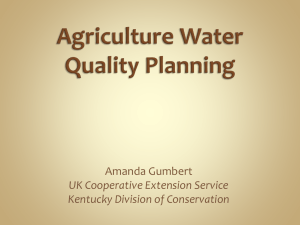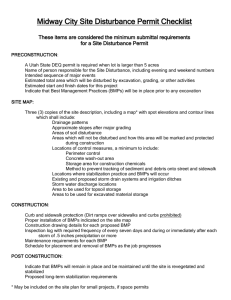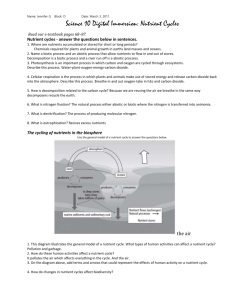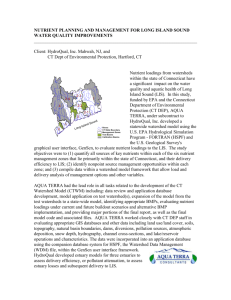15A NCAC 02B .0256 TAR-PAMLICO RIVER BASIN
advertisement
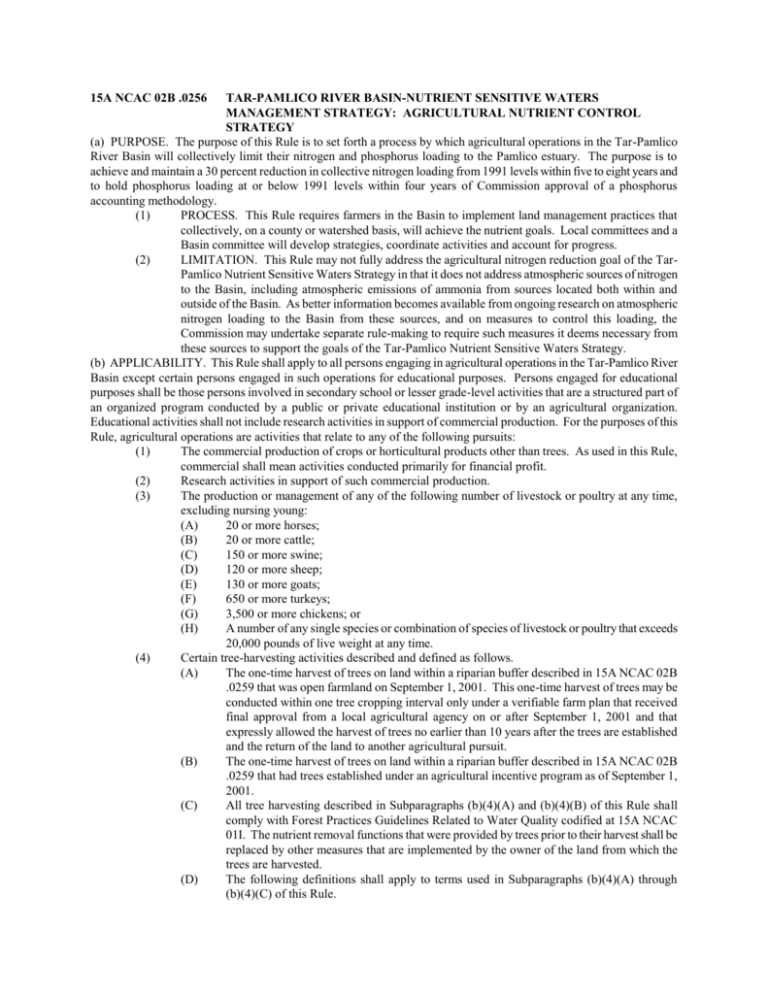
15A NCAC 02B .0256 TAR-PAMLICO RIVER BASIN-NUTRIENT SENSITIVE WATERS MANAGEMENT STRATEGY: AGRICULTURAL NUTRIENT CONTROL STRATEGY (a) PURPOSE. The purpose of this Rule is to set forth a process by which agricultural operations in the Tar-Pamlico River Basin will collectively limit their nitrogen and phosphorus loading to the Pamlico estuary. The purpose is to achieve and maintain a 30 percent reduction in collective nitrogen loading from 1991 levels within five to eight years and to hold phosphorus loading at or below 1991 levels within four years of Commission approval of a phosphorus accounting methodology. (1) PROCESS. This Rule requires farmers in the Basin to implement land management practices that collectively, on a county or watershed basis, will achieve the nutrient goals. Local committees and a Basin committee will develop strategies, coordinate activities and account for progress. (2) LIMITATION. This Rule may not fully address the agricultural nitrogen reduction goal of the TarPamlico Nutrient Sensitive Waters Strategy in that it does not address atmospheric sources of nitrogen to the Basin, including atmospheric emissions of ammonia from sources located both within and outside of the Basin. As better information becomes available from ongoing research on atmospheric nitrogen loading to the Basin from these sources, and on measures to control this loading, the Commission may undertake separate rule-making to require such measures it deems necessary from these sources to support the goals of the Tar-Pamlico Nutrient Sensitive Waters Strategy. (b) APPLICABILITY. This Rule shall apply to all persons engaging in agricultural operations in the Tar-Pamlico River Basin except certain persons engaged in such operations for educational purposes. Persons engaged for educational purposes shall be those persons involved in secondary school or lesser grade-level activities that are a structured part of an organized program conducted by a public or private educational institution or by an agricultural organization. Educational activities shall not include research activities in support of commercial production. For the purposes of this Rule, agricultural operations are activities that relate to any of the following pursuits: (1) The commercial production of crops or horticultural products other than trees. As used in this Rule, commercial shall mean activities conducted primarily for financial profit. (2) Research activities in support of such commercial production. (3) The production or management of any of the following number of livestock or poultry at any time, excluding nursing young: (A) 20 or more horses; (B) 20 or more cattle; (C) 150 or more swine; (D) 120 or more sheep; (E) 130 or more goats; (F) 650 or more turkeys; (G) 3,500 or more chickens; or (H) A number of any single species or combination of species of livestock or poultry that exceeds 20,000 pounds of live weight at any time. (4) Certain tree-harvesting activities described and defined as follows. (A) The one-time harvest of trees on land within a riparian buffer described in 15A NCAC 02B .0259 that was open farmland on September 1, 2001. This one-time harvest of trees may be conducted within one tree cropping interval only under a verifiable farm plan that received final approval from a local agricultural agency on or after September 1, 2001 and that expressly allowed the harvest of trees no earlier than 10 years after the trees are established and the return of the land to another agricultural pursuit. (B) The one-time harvest of trees on land within a riparian buffer described in 15A NCAC 02B .0259 that had trees established under an agricultural incentive program as of September 1, 2001. (C) All tree harvesting described in Subparagraphs (b)(4)(A) and (b)(4)(B) of this Rule shall comply with Forest Practices Guidelines Related to Water Quality codified at 15A NCAC 01I. The nutrient removal functions that were provided by trees prior to their harvest shall be replaced by other measures that are implemented by the owner of the land from which the trees are harvested. (D) The following definitions shall apply to terms used in Subparagraphs (b)(4)(A) through (b)(4)(C) of this Rule. (i) "Agricultural incentive program" means any of the following programs and any predecessor program to any of the following programs: (I) Agriculture Cost Share Program for Nonpoint Source Pollution Control established by G.S. 143-215.74. (II) Conservation Reserve Enhancement Program established by 7 C.F.R. Part 1410 (January 1, 2001 Edition) and 15A NCAC 06G .0101 through 15A NCAC 06G .0106. (III) Conservation Reserve Program established by 7 C.F.R. Part 1410 (January 1, 2001 Edition). (IV) Environmental Quality Incentives Program established by 7 C.F.R. Part 1466 (January 1, 2001 Edition). (V) Wetlands Reserve Program established by 7 C.F.R. Part 1467 (January 1, 2001 Edition). (VI) Wildlife Habitat Incentives Program established by 7 C.F.R. Part 636 (January 1, 2001 Edition). (ii) "Local agricultural agency" means the North Carolina Cooperative Extension Service, the Farm Services Agency of the United States Department of Agriculture, the Natural Resources Conservation Service of the United States Department of Agriculture, a Soil and Water Conservation District created pursuant to G.S. 139-5, or their successor agencies. (iii) "Open farmland" means the footprint of land used for pasture or for crops or horticultural products other than trees. Open farmland may contain scattered trees if an open canopy existed on September 1, 2001 as determined from the most recent aerial photographs taken prior to September 1, 2001 for the Farm Services Agency of the United States Department of Agriculture. (iv) "Tree" means a woody plant with a diameter equal to or greater than five inches when measured at a height of four and one-half feet above the ground. (v) "Tree cropping interval" means the time required to establish and grow trees that are suitable for harvesting. The tree-cropping interval shall be set out in the farm plan and shall be no less than 10 years after the trees are established. (c) METHOD FOR RULE IMPLEMENTATION. This Rule shall be implemented through a cooperative effort between a Basin Oversight Committee and Local Advisory Committees in each county or watershed. The membership, roles and responsibilities of these committees are set forth in Paragraphs (f) and (g) of this Rule. Committees' activities shall be guided by the following constraints: (1) The Commission shall determine whether each Local Advisory Committee has achieved its nitrogen reduction goal within five years of the effective date of this Rule, and its phosphorus loading goal within four years of the date that a phosphorus accounting method is approved by the Commission, both based on the accounting process described in Paragraphs (f) and (g) of this Rule. Should the Commission determine that a Local Advisory Committee has not achieved its nitrogen goal within five years, then the Commission shall require additional BMP implementation as needed to ensure that the goal is met within eight years of the effective date of this Rule. The Commission shall similarly review compliance with the phosphorus goal four years after it approves a phosphorus accounting method, and shall require additional BMP implementation as needed to meet that goal within an additional three years from that date. All persons subject to this Rule who have not implemented BMPs in accordance with an option provided in Subparagraphs (d)(1) or (d)(2) of this Rule shall be subject to such further requirements deemed necessary by the Commission for any Local Advisory Committee that has not achieved a nutrient goal. (2) Should a committee not form or not follow through on its responsibilities such that a local strategy is not implemented in keeping with Paragraph (g) of this Rule, the Commission may require all persons subject to this Rule in the affected area to implement BMPs as set forth in Paragraph (e) of this Rule. (d) OPTIONS FOR MEETING RULE REQUIREMENTS. Persons subject to this Rule shall register their operations with their Local Advisory Committee according to the requirements of Paragraph (g) of this Rule within one year of the effective date of this Rule. Such persons may elect to implement any BMPs they choose that are recognized by the Basin Oversight Committee as nitrogen-reducing BMPs within five years of the effective date of this Rule. Persons who implement one of the following two options within five years of the effective date of this Rule for nitrogen-reducing BMPs and within four years of the date that a phosphorus accounting method is approved by the Commission shall not be subject to any additional requirements that may be placed on persons under Paragraph (c) of this Rule. Persons subject to this Rule shall be responsible for implementing and maintaining the BMPs used to meet the requirements of this Rule for as long as they continue their agricultural operation. If a person ceases an operation and another person assumes that operation, the new operator shall be responsible for implementing BMPs that meet the requirements of this Paragraph. (1) Option 1 is to implement site-specific BMPs that are accepted by the Local Advisory Committee as fully satisfying a person's obligations under this Rule based on BMP implementation needs identified in the local nutrient control strategy required under Subparagraph (g)(3)of this Rule and on nutrient reduction efficiencies established by the Basin Oversight Committee as called for under Subparagraphs (f)(2) and (f)(3) of this Rule. (2) Option 2 is to implement standard BMPs that persons subject to this Rule choose from the alternatives established pursuant to Paragraph (e) of this Rule. (e) STANDARD BEST MANAGEMENT PRACTICES (BMPs). Standard BMPs shall be individual BMPs or combinations of BMPs that achieve at least a 30 percent reduction in nitrogen loading and no increase in phosphorus loading relative to conditions that lack such BMPs. Standard BMPs shall be established for the purposes of this Rule by one of the following processes: (1) The Soil and Water Conservation Commission may elect to approve, under its own authorities, standard BMP options for the Tar-Pamlico River Basin based on nutrient reduction efficiencies established by the Basin Oversight Committee pursuant to Subparagraph (f)(3) of this Rule and using criteria for nitrogen- and phosphorus-reducing BMPs as described in rules adopted by the Soil and Water Conservation Commission, including 15A NCAC 06E .0104 and 15A NCAC 06F .0104. One purpose of this process is to provide persons subject to this Rule the opportunity to work with the Soil and Water Conservation Commission in its development of standard BMP options; or (2) In the unlikely event that the Soil and Water Conservation Commission does not approve an initial set of standard BMP options for the Tar-Pamlico River Basin within one year of the effective date of this Rule, then the Environmental Management Commission may approve standard BMP options within eighteen months of the effective date of this Rule. In that event, the standard BMP options approved by the Commission shall be designed to reduce nitrogen and phosphorus loading, as specified at the beginning of Paragraph (e) of this Rule, from agricultural sources through structural, management, or buffering farming BMPs or animal waste management plan components. (f) BASIN OVERSIGHT COMMITTEE. The Basin Oversight Committee shall have the following membership, role and responsibilities: (1) MEMBERSHIP. The Commission shall delegate to the Secretary the responsibility of forming a Basin Oversight Committee within two months of the effective date of this Rule. Members shall be appointed for five-year terms and shall serve at the pleasure of the Secretary. Until such time as the Commission determines that long-term maintenance of the nutrient loads is assured, the Secretary shall either reappoint members or replace members every five years. The Secretary shall solicit nominations for membership on this Committee to represent each of the following interests, and shall appoint one nominee to represent each interest. The Secretary may appoint a replacement at any time for an interest in Parts (f)(1)(F) through (f)(1)(J) of this Rule upon request of representatives of that interest: (A) Division of Soil and Water Conservation; (B) United States Department of Agriculture-Natural Resources Conservation Service (shall serve in an "ex-officio" non-voting capacity and shall function as a technical program advisor to the Committee); (C) North Carolina Department of Agriculture and Consumer Services; (D) North Carolina Cooperative Extension Service; (E) Division of Water Quality; (F) Environmental interests; (G) Basinwide farming interests; (H) Pasture-based livestock interests; (I) Cropland farming interests; and (J) The scientific community with experience related to water quality problems in the TarPamlico River Basin. (2) ROLE. The Basin Oversight Committee shall: (A) Develop a tracking and accounting methodology pursuant to Subparagraph (f)(3) of this Rule. A final nitrogen methodology shall be submitted to the Commission for approval within one year after the effective date of this Rule. A final methodology for phosphorus shall be submitted at the earliest date possible as determined by the Basin Oversight Committee with input from the technical advisory committee described in Part (f)(2)(D) of this Rule. (B) Identify and implement future refinements to the accounting methodology as needed to reflect advances in scientific understanding, including establishment of nutrient reduction efficiencies for BMPs. (C) Appoint a technical advisory committee within 6 months of the effective date of this Rule to inform the Basin Oversight Committee on rule-related issues. The Basin Oversight Committee shall direct the committee to take the following actions at a minimum: monitor advances in scientific understanding related to phosphorus loading, evaluate the need for additional management action to meet the phosphorus loading goal, and report its findings to the Basin Oversight Committee on an annual basis. The Basin Oversight Committee shall in turn report these findings and its recommendations to the Commission on an annual basis following the effective date of this Rule, until such time as the Commission, with input from the Basin Oversight Committee, determines that the technical advisory committee has fulfilled its purpose. The Basin Oversight Committee shall solicit nominations for this committee from the Division of Soil and Water Conservation, United States Department of Agriculture-Natural Resources Conservation Service, North Carolina Department of Agriculture and Consumer Services, North Carolina Cooperative Extension Service, Division of Water Quality, environmental interests, agricultural interests, and the scientific community with experience related to the committee's charge. (D) Review, approve and summarize county or watershed local strategies and present these strategies to the Commission for approval within two years after the effective date of this Rule. (E) Establish minimum requirements for, review, approve and summarize local nitrogen and phosphorus loading annual reports as described under Subparagraph (g)(5) of this Rule, and present these reports to the Commission each October, until such time as the Commission determines that annual reports are no longer needed to assure long-term maintenance of the nutrient goals. (3) ACCOUNTING METHODOLOGY. The Basin Oversight Committee shall develop an accounting methodology that meets the following requirements: (A) The methodology shall quantify baseline total nitrogen and phosphorus loadings from agricultural operations in each county and for the entire basin. (B) The methodology shall include a means of tracking implementation of BMPs, including number, type, and area affected. (C) The methodology shall include a means of estimating incremental nitrogen and phosphorus reductions from actual BMP implementation and of evaluating progress toward the nutrient goals from BMP implementation. The methodology shall include nutrient reduction efficiencies for individual BMPs and combinations of BMPs that can be implemented toward the nitrogen and phosphorus goals. (D) The methodology shall allow for future refinements to the nutrient baseline loading determinations, and to the load reduction accounting methodology. (E) The methodology shall provide for quantification of changes in nutrient loading due to changes in agricultural land use, modifications in agricultural activity, or changes in atmospheric nitrogen loading to the extent allowed by advances in technical understanding. (F) The methodology shall include a method to track maintenance of the nutrient net loads after the initial eight years of this Rule, including tracking of changes in BMPs and additional BMPs to offset new or increased sources of nutrients from agricultural operations. (g) LOCAL ADVISORY COMMITTEES. The Local Advisory Committees shall have the following membership, roles, and responsibilities: (1) MEMBERSHIP. A Local Advisory Committee shall be appointed as provided in this Paragraph in each county (or watershed as specified by the Basin Oversight Committee) within the Tar-Pamlico (2) (3) (4) River Basin. As directed by S.L. 2001, c. 355, the Local Advisory Committees shall be appointed on or before November 1, 2001. They shall terminate upon a finding by the Environmental Management Commission that the long-term maintenance of nutrient loads in the Tar-Pamlico River Basin is assured. Each Local Advisory Committee shall consist of: (A) One representative of the local Soil and Water Conservation District; (B) One local representative of the United States Department of Agriculture- Natural Resources Conservation Service; (C) One local representative of the North Carolina Department of Agriculture and Consumer Services; (D) One local representative of the North Carolina Cooperative Extension Service; (E) One local representative of the North Carolina Division of Soil and Water Conservation; and (F) At least five, but not more than 10 farmers who reside in the county or watershed. APPOINTMENT OF MEMBERS. The Director of the Division of Water Quality and the Director of the Division of Soil and Water Conservation of the Department of Environment and Natural Resources shall jointly appoint members described in Subparagraphs (g)(1)(A), (g)(1)(B), (g)(1)(D), and (g)(1)(E) of this Rule. As directed by S.L. 2001, c. 355, the Commissioner of Agriculture shall appoint the members described in Subparagraphs (g)(1)(C) and (g)(1)(F) of this Rule from persons nominated by nongovernmental organizations whose members produce or manage significant agricultural commodities in each county or watershed. Members of the Local Advisory Committees shall serve at the pleasure of their appointing authority. ROLE. The Local Advisory Committees shall: (A) Conduct a registration process for persons subject to this Rule. This registration process shall be completed within one year after the effective date of this Rule. It shall obtain information that shall allow Local Advisory Committees to develop local strategies in accordance with Subparagraph (g)(4) of this Rule. At minimum, the registration process shall request the type and acreage of agricultural operations, nutrient-reducing BMPs implemented since January 1, 1992 and their operational status, and the acres affected by those BMPs. It shall provide persons with information on requirements and options under this Rule, and on available technical assistance and cost share options; (B) Designate a member agency to compile and retain copies of all individual plans produced to comply with this Rule; (C) Develop local nutrient control strategies for agricultural operations, pursuant to Subparagraph (g)(4) of this Rule, to meet the nitrogen and phosphorus goals assigned by the Basin Oversight Committee. The nitrogen component of the control strategy shall be submitted to the Basin Oversight Committee no later than twenty-three months from the effective date of this Rule. The phosphorus component of the control strategy shall be submitted within one year of the date that the Commission approves a phosphorus accounting methodology as described in Part (f)(2)(A) of this Rule; (D) Ensure that any changes to the design of the local strategy will continue to meet the nutrient goals of this Rule; and (E) Submit annual reports to the Basin Oversight Committee, pursuant to Subparagraph (g)(5) of this Rule, each May until such time as the Commission determines that annual reports are no longer needed to assure long-term maintenance of the nutrient goals. LOCAL NUTRIENT CONTROL STRATEGIES. The Local Advisory Committees shall be responsible for developing county or watershed nutrient control strategies that meet the following requirements. If a Local Advisory Committee fails to submit a nutrient control strategy as required in Part (g)(3)(C) of this Rule, the Commission may develop one based on the accounting methodology that it approves pursuant to Part (f)(2)(A) of this Rule. (A) Local nutrient control strategies shall be designed to achieve the required nitrogen reduction goals within five years after the effective date of this Rule, and to maintain those reductions in perpetuity or until such time as this Rule is revised to modify this requirement. Strategies shall be designed to meet the phosphorus loading goals within four years of the date that the Commission approves a phosphorus accounting methodology as described in Part (f)(2)(A) of this Rule. (B) (5) History Note: Local nutrient control strategies shall specify the numbers and types of all agricultural operations within their areas, numbers of BMPs that will be implemented by enrolled operations and acres to be affected by those BMPs, estimated nitrogen and phosphorus reductions, schedule for BMP implementation, and operation and maintenance requirements. (C) Local nutrient control strategies may prioritize BMP implementation to establish the most efficient and effective means of achieving the nutrient goals. ANNUAL REPORTS. The Local Advisory Committees shall be responsible for submitting annual reports for their counties or watersheds. Annual reports shall be submitted to the Basin Oversight Committee each May until such time as the Commission determines that annual reports are no longer needed to assure long-term maintenance of the nutrient goals. Annual reports shall quantify progress toward the nutrient goals with sufficient detail to allow for compliance monitoring at the farm level. The Basin Oversight Committee shall determine reporting requirements to meet these objectives. Those requirements may include information on BMPs implemented by individual farms, proper BMP operation and maintenance, BMPs discontinued, changes in agricultural land use or activity, and resultant net nutrient loading changes. Authority G.S. 143-214.1; 143-214.7; 143-215.3(a)(1); 143-215.6A; 143-215.6B; 143-215.6C; S.L. 2001-355; Eff. September 1, 2001; Temporary Amendment Eff. January 1, 2002 (exempt from 270 day requirement-S.L. 2001-355).

